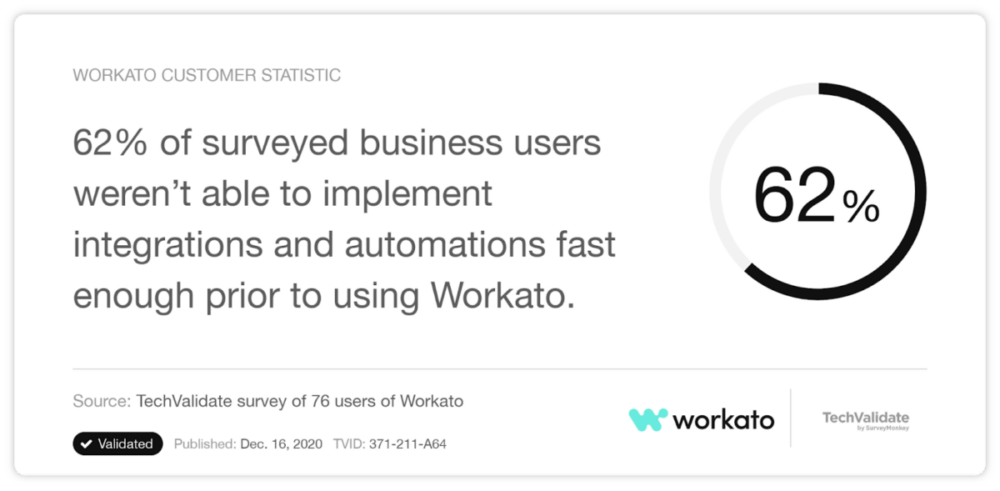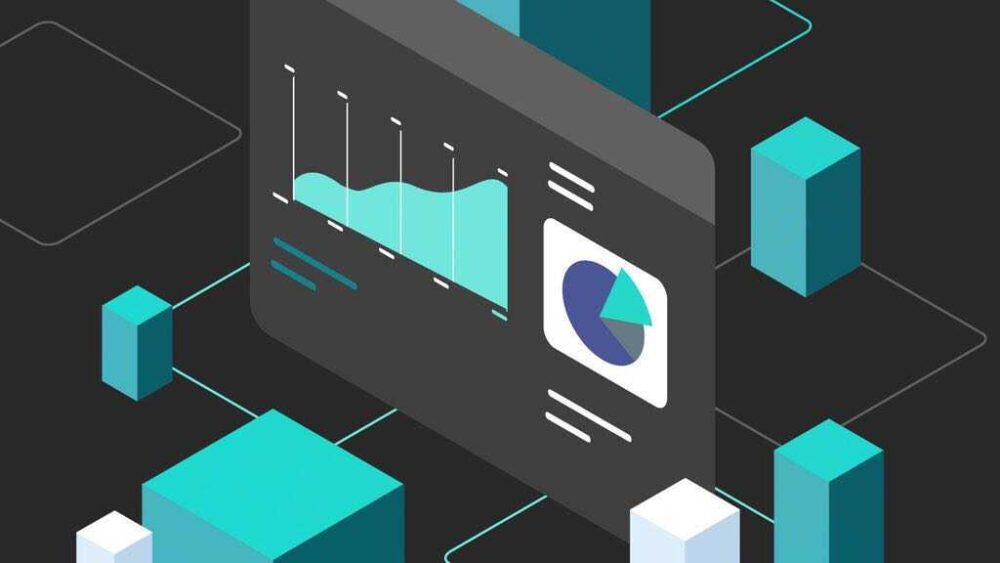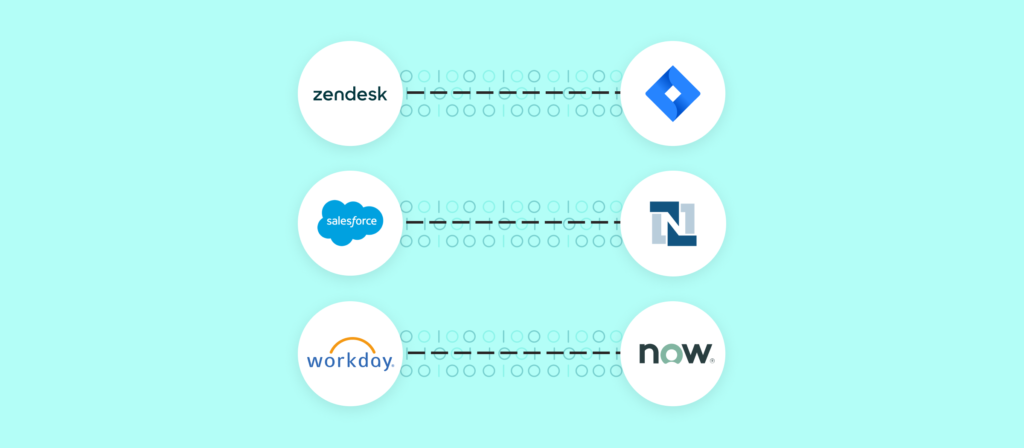As organizations continue to adopt more technology, the average business now uses over 100 SaaS applications across its departments. To manage and leverage these applications effectively, organizations often turn to various integration methods, such as point-to-point (P2P) integration.
While P2P integration might seem like a straightforward solution for connecting these applications, it can lead to a host of issues—such as creating data silos. This forces employees to manually re-enter information across multiple platforms. Thus, hindering access to critical data needed by different lines of business.
Despite its initial appeal, point-to-point integration can ultimately result in disastrous outcomes for businesses. Why does this integration approach fall short, and what alternative strategies can you employ to connect your apps and move data between them seamlessly?
In this article, we’ll explore the pitfalls of point-to-point integrations. We’ll also provide insights into a more scalable and efficient way to integrate your technology ecosystem.
What the future of integration looks like
Download whitepaperWhat is point-to-point integration?
Point-to-point integration (also called peer-to-peer integration, or P2P integration) is the process of connecting two separate software applications or systems directly to exchange data and communicate without intermediaries. It typically involves a one-to-one connection between two endpoints.

In this approach, custom code is used to establish these direct connections. Multiple technologies can be used to write the code. This allows your team to build a network of point-to-point integrations across different coding languages. This can lead to cost savings by avoiding the need for third-party middleware or complex integration platforms, particularly for straightforward integrations between key applications.
Related: A guide to enterprise application integration
Point-to-Point Integration vs. Hub-and-Spoke Integration
While point-to-point integration directly connects two applications, hub-and-spoke integration centralizes the connections through a single hub (the “spoke” being the various connected applications).
In the hub-and-spoke model, all communication between applications flows through the central hub, which acts as an intermediary. This allows for easier management and visibility of integrations. It also fosters the ability to scale more efficiently by adding new applications to the hub without creating new direct connections between each system.
Pros of Hub-and-Spoke Integration:
- Scalability: Instead of managing multiple direct connections, you can add new systems to the central hub without increasing complexity.
- Centralized Control: The hub provides better visibility into all integrations, making monitoring and troubleshooting easier.
- Resilience: The hub can often handle error detection and recovery, improving the stability of the entire integration network.
Cons of Hub-and-Spoke Integration:
- Single Point of Failure: If the hub goes down, it can affect the entire integration network, creating downtime across connected systems.
- Higher Initial Cost: Implementing a hub-and-spoke model often requires investing in more advanced integration infrastructure, making it a pricier option upfront.
How Point-to-Point Integration Works
Point-to-point integration functions by establishing direct connections between two systems or applications to enable them to communicate and exchange data. The integration is typically achieved using custom code and Application Programming Interfaces (APIs).
What is the role of APIs in point-to-point integration?
APIs act as the bridge that allows applications to interact with each other in a structured way. In point-to-point integrations, APIs define the rules for how data should be exchanged between the two systems. They ensure that both applications can request and share the necessary information without conflict.
What APIs do point-to-point integrations leverage?
Point-to-point integrations typically leverage REST (Representational State Transfer) and SOAP (Simple Object Access Protocol) APIs, depending on the systems being connected. REST APIs are favored for their simplicity and scalability. SOAP APIs offer more robust security and transaction support. Other API types, such as GraphQL or proprietary APIs, may also be used based on the specific requirements of the applications.
What is the role of security measures in point-to-point integration?
Given the direct connection between systems, security measures are crucial in point-to-point integrations. These integrations often involve sensitive data transfer. They require encryption protocols (such as TLS/SSL) to ensure data is secure during transmission. Authentication methods like OAuth, API keys, and tokens help verify that only authorized systems and users can access the data. Proper security controls are essential to prevent data breaches, ensure compliance, and protect the integrity of the connected systems.

Situations where it might make sense to use point-to-point integration
This integration solution can be a suitable choice in the right situations—especially when each of the following holds true.
1. The integration is relatively shallow in scope
When the integration’s capabilities are fairly straightforward, your team doesn’t need to invest as much time and resources on building and maintaining it.
2. There’s only one integration to build
With just a single integration to worry about building and maintaining, the task becomes more manageable for your team. Moreover, your team doesn’t need to acquire expertise in building to multiple complex APIs—which likely leads to hiring expensive employees.
3. The integration can be a significant growth lever for your business
Not all point-to-point connections have an equal impact on your employees, clients, or prospects. Prioritizing one that can have an outsized influence makes the process of managing it in-house all the more sensible. Related: How to decide between building and buying integrations
The disadvantages of using point-to-point integration
Even when your business faces one of the situations above, it may be worth avoiding point-to-point integration. At the very least, you should minimize your reliance on this approach. Here’s why:
1. It’s time-consuming to implement
The process of building out a single point-to-point integration can be drawn out, hurting your dev team’s ability to meet stakeholders’ needs and the organization’s more broadly.
We discovered this first-hand when surveying our customers: Before using Workato, the leader in integration-led automation, the majority of our respondents said that they weren’t building integrations fast enough.

Though some of these respondents may have previously relied on an ESB, a traditional integration platform as a service (iPaaS) or on native integrations, it’s fair to assume that many used point-to-point integrations.
2. It isn’t scalable
Whether you work at a startup or at an enterprise organization, you’re likely using more than 100 SaaS apps across your business. The prospect of building point-to-point integrations across all these apps—or even a high share of them—is likely unattainable, forcing many to operate in silos.
3. It isn’t future-proof
The apps you want and the way you want them to interact will shift as your business evolves and your requirements change. Point-to-point integrations simply aren’t designed to keep up with such changes, making them less than ideal over time.
4. It forces your organization to depend on a few employees
Only a handful of employees know how to code in any language—let alone specific ones, like Python. This means that as employees who’ve built point-to-point integrations leave the company, the valuable knowledge that’s required to maintain and fix your integrations go with them.
5. It’s difficult to track
The absence of a centralized means for tracking your P2P integrations leaves many on your team unaware of which exist and how they’re running. This lack of transparency makes it painfully difficult to monitor your network of integrations and troubleshoot any over time.
Fortunately, there’s a better way to connect your apps and move data between them, and that’s through an integration-led automation platform.
Related: 3 disadvantages of using a legacy system
How an integration-led automation platform addresses P2P integration’s drawbacks
Using this type of platform, you can connect apps quickly and at scale via pre-built connectors. Here’s more on the platform’s functionality and how it can address your business needs:
1. It offers a low-code/no-code UX that empowers lines of business to build integrations
As an integration-led automation platform doesn’t require writing a line of code, employees across lines of business can use it themselves to build integrations. This, in and of itself, can help your organization quickly scale its integration-building efforts as well as overcome its backlog of integrations efficiently.
In addition, since you’re allowing the employees who consistently use the apps and that have experience with the workflows to implement everything themselves. They’re more likely to build integrations and automation that do a better job of addressing their team’s needs.
2. It provides a dashboard that gives you full visibility
The ability to track the integrations and automation you’re building. You can see how they’re running is critical, both in keeping your data secure and in ensuring that issues get resolved on time.
To that end, an integration-led automation platform provides a dashboard that lets your team view the various activities performed in the platform along customizable time frames. This includes everything from the apps connected to the workflows implemented to the jobs that ran.

3. It allows you to build end-to-end automations that can transform your workflows
Connecting your apps and allowing the data to flow between them in near real-time can be critical to your business. But it doesn’t fundamentally change the way your team operates. What can? Integrating your apps AND implementing end-to-end workflow automations across important processes, such as lead routing, quote to cash, and employee onboarding.
This type of automation can help your team provide experiences that delight customers, engage prospects, and enable employees. In turn, this allows you to meet key business goals, as measured by customer retention, customer acquisition, employee retention, etc.
Workato, the leader in enterprise automation, offers a platform that has all of these features, among many others, so that you can automate at scale.
Conclusion
While point-to-point integration may seem like a convenient and cost-effective solution for connecting a few applications, it quickly becomes problematic as your business grows and your technology stack expands. The challenges of scalability, maintenance, and security can hinder operational efficiency and create bottlenecks in your processes.
To meet the demands of modern businesses, more scalable solutions like hub-and-spoke integration or integration-led automation platforms are necessary. These alternatives offer centralized control, easier scalability, and stronger security measures. This allows your business to operate seamlessly across various applications.

Want to learn more about our platform?
Discover how Workato can transform your workflows by scheduling a demo with one of our automation experts.
